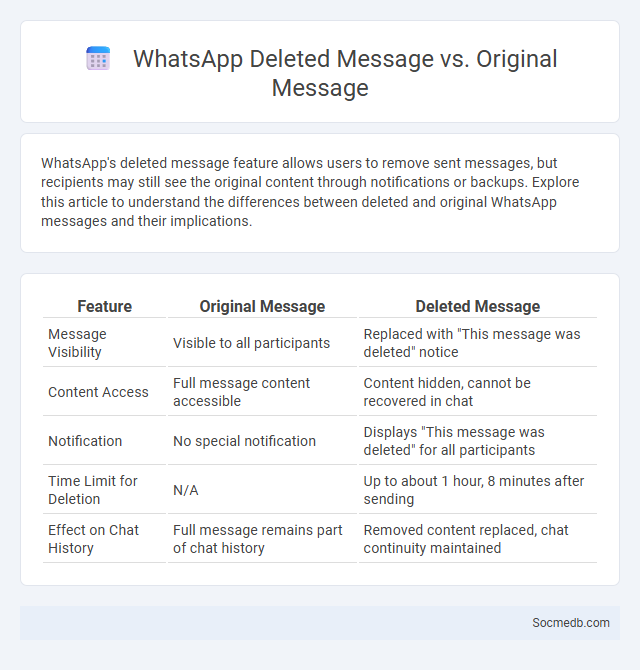
Photo illustration: WhatsApp Deleted Message vs Original Message
WhatsApp's deleted message feature allows users to remove sent messages, but recipients may still see the original content through notifications or backups. Explore this article to understand the differences between deleted and original WhatsApp messages and their implications.
Table of Comparison
| Feature | Original Message | Deleted Message |
|---|---|---|
| Message Visibility | Visible to all participants | Replaced with "This message was deleted" notice |
| Content Access | Full message content accessible | Content hidden, cannot be recovered in chat |
| Notification | No special notification | Displays "This message was deleted" for all participants |
| Time Limit for Deletion | N/A | Up to about 1 hour, 8 minutes after sending |
| Effect on Chat History | Full message remains part of chat history | Removed content replaced, chat continuity maintained |
Introduction to WhatsApp Messaging Terminologies
WhatsApp messaging terminologies include key terms such as chats, groups, broadcast lists, and media sharing, each enhancing communication efficiency. Understanding features like end-to-end encryption, read receipts (blue ticks), and voice notes ensures your interactions remain secure and clear. Mastering these concepts allows you to navigate WhatsApp effectively, optimizing your social media experience.
Understanding Original Messages on WhatsApp
Understanding original messages on WhatsApp involves recognizing the sender's intent, context, and the message's authenticity to avoid misinformation. Analyzing message timing, sender profile, and multimedia content helps verify the originality and prevents the spread of altered or forwarded texts. Effective comprehension enhances communication clarity and fosters trust among users on the platform.
What Happens When a Message Is Deleted?
When a message is deleted on social media platforms like Facebook or Instagram, it is typically removed from both the sender's and recipient's chat history, enhancing user privacy and reducing clutter. Most platforms move deleted messages to a temporary queue or use encryption keys to revoke access, preventing retrieval or viewing by either party. However, metadata or backups may still retain traces of the deleted content for a limited time, depending on platform policies and data retention laws.
Exploring the ‘Delete for Everyone’ Feature
The 'Delete for Everyone' feature on social media platforms allows users to remove messages from both their own and recipients' chats within a specific time frame. This functionality helps maintain your digital privacy by preventing unintended content from lingering in conversations. Understanding the exact conditions and time limits of this feature ensures you can use it effectively to control your message history.
The Concept of Revoked Messages in WhatsApp
Revoked messages in WhatsApp allow users to delete sent texts and media from both their own and recipients' chats, enhancing control over shared content. This feature supports privacy by enabling message removal within a specific time frame, typically up to about an hour after sending. You can use revoked messages to manage misunderstandings, correct errors, or retract sensitive information before it is seen.
Differences Between Deleted and Revoked Messages
Deleted messages are removed from the sender's device, making the content inaccessible to them but potentially still visible to recipients. Revoked messages are withdrawn from both sender and recipient devices, ensuring the content is no longer accessible or visible to any party involved. Social media platforms like WhatsApp and Telegram implement message revocation features to enhance privacy and control over shared content.
Message Retrieval: Can You See Deleted or Revoked Content?
Message retrieval on social media platforms depends on the specific app's policies and technology; typically, deleted or revoked content becomes inaccessible to regular users once removed. Some platforms may retain deleted messages temporarily on servers or in backups, enabling limited recovery by authorized entities or through third-party tools with varying success. Privacy regulations and encryption standards heavily influence whether revoked content can be seen, emphasizing user control over message visibility.
Privacy Implications of Message Deletion and Revocation
Message deletion and revocation on social media platforms raise significant privacy implications by potentially creating gaps in communication records that can be exploited or misinterpreted. Users should understand that while revoking messages may limit recipient access, deleted content could persist in backups, logs, or be captured by third-party apps, placing Your privacy at risk. Awareness of platform-specific policies and using end-to-end encryption tools are key strategies to enhance control over Your private data.
User Experience: Handling Deleted, Revoked, and Original Messages
Efficient handling of deleted, revoked, and original messages significantly enhances your social media user experience by maintaining clarity and control over communications. Platforms that implement intuitive message status indicators and seamless recovery options allow users to understand conversation context and manage their interactions securely. Prioritizing transparency in message modifications fosters trust and reduces confusion, ultimately improving overall engagement.
Best Practices for Managing Messages on WhatsApp
Effective WhatsApp message management relies on promptly responding to inquiries, organizing chats using labels, and setting up automated replies for common questions. Leveraging broadcast lists ensures streamlined communication with multiple contacts without creating group chats, enhancing message personalization and reach. Regularly archiving inactive conversations and enabling message filtering improve chat accessibility and maintain an organized inbox.
 socmedb.com
socmedb.com